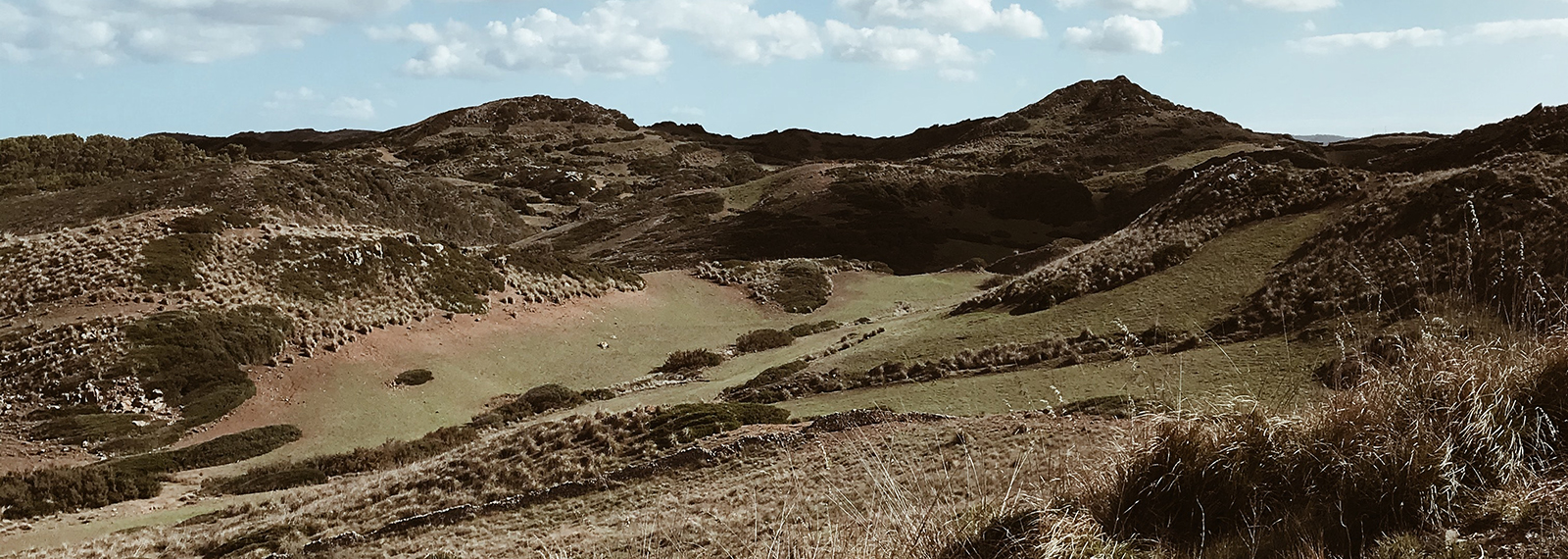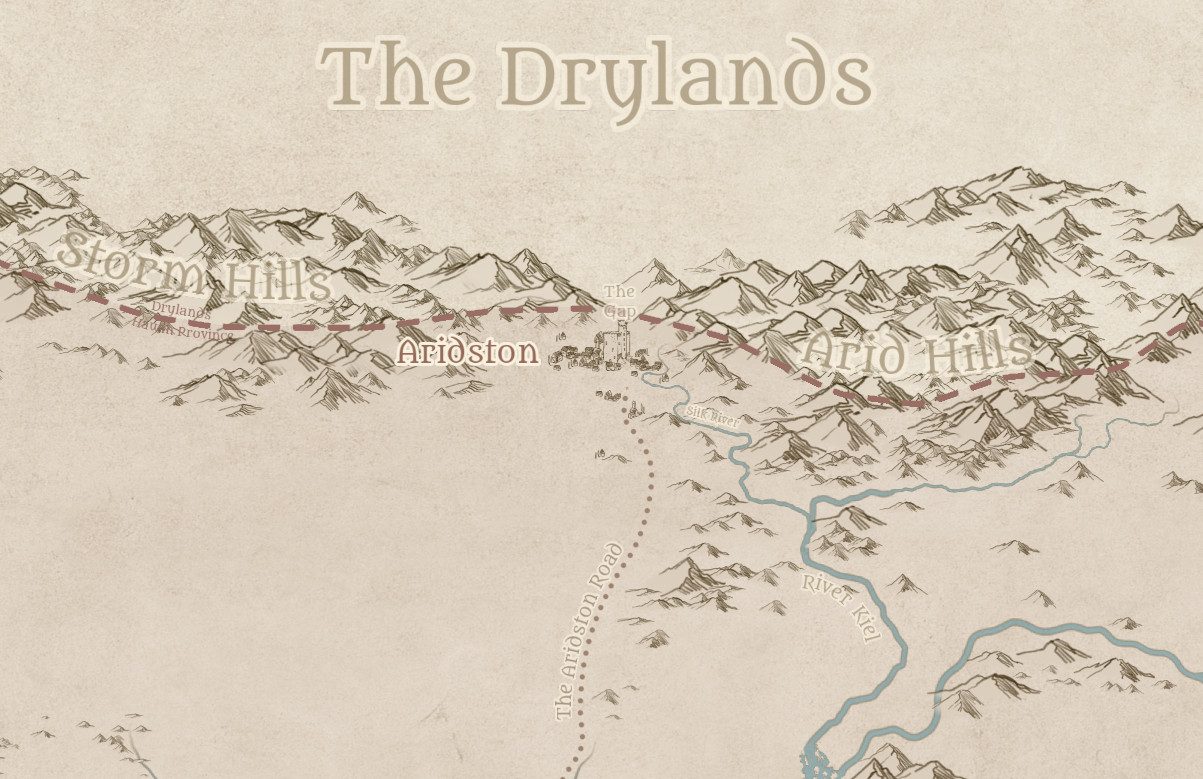Aridston
the town of a billion legs
Aridston is the northern most large town in Hawm Province, on of the eastern provinces of the great unified human nation of Austur. It is nestled in a gap between the Dry Hills to the east, and the Storm Hills to the west. The gap leads northward into the Drylands, a vast rolling expanse of semi-desert scrubland that stretches eastward into skla'vin territory and northward to an unknown extent well past Austur's official borders.
Like many other Farm town in Austur, Aridston is focused on a single specialization, and that specialization is only produced there. In the case of Aridston, that specialization is the raising and farming of ranea, a large spider-like creature, that produces a valuable silk thread, amongst other things. The ranea are only semi-domesticated, and can only live and be bred in the dry, sandy soil, and high temperatures of northern Hawm Province and the Drylands.
Demographics
The population of Aridston is almost entirely guild citizens from The Book of The Farm. There are those from The Books of the Town, Wild and Craft of course to support the town and the farmers, but only a token number of Guardsmen. There is a proportionally lower number of wards in the town than one would expect, owing to the average farmer not being inclined to their use. There is also an unusually high proportion of Umas, as there tend to be in remote Farm towns and villages.
Since ranea farming is relatively specialized, and that is the only real industry of the town and area around it, the population is relatively stagnant. This has resulted in a slightly unique effect where the vast majority of the townsfolk and surrounding farmers are of olde easterner stock. More unusual than that, they are almost universally of below average height and of a more gracile build, even for olde easterners.
It is rumoured that the Council's decree allowing inter-Book marriages in the early 700s, was in part to counter inbreeding in remote, specialized Farm settlements like Aridston, where the guilds would not allow emigration.
Defences
There is a small Mageguard keep and tower on the north edge of the town, leading into the gap, but it is manned only by a few dozen guardsmen at any given time. The majority of these are from the Order of the Stonecutters, and kept a revolving patrol around the town and it's outlying farms to watch for and deal with any wayward vaaneck that may come over the hills to hunt.
Industry & Trade
The primary, and almost solitary, industry of the town and the entire industry is ranea farming.
Usable products of the ranea are
silk thread
esonya (venom)
"young" meat
whole thorax
The silk is used both for clothing amongst certain of the townie guilds, and for sails on ocean going vessels.
Though slightly addictive, esonya is an incredibly effective pain killer and relaxant with some minimal processing and is a staple of any healer's bag.
Ranea meat comes in two form, "young" and "mature". The "young" is occasionally harvested as a part of a cull or for special occasions, from a ranea too young to yet produce venom. This is almost exclusively eat by ranea farmers and those around Aridston, but can be found occasionally for festival days in Hawm City or Puggers Bank. The "mature" meat is not unsafe for human consumption, but is extremely unpleasant.
Whole thoraxes are harvested when an adult ranea has reached the end of it's silk production years, usually about five years. They are not hugely valuable, but are collected, dried out and exported to the skla'vin Queens, who enjoy consuming some unknown part of the desiccated remnants.
Infrastructure
Though it is fairly large for a farming town, Aridston is still just that. Compared to cities in the province like Puggers Bank or Longshore, with populations in the tens of thousands, "the village in the gap" was barely three thousand. It's distance from any city or it's provincial capital however, means that basic services need to be provided.
Despite it's tiny size, Aridston still has all the basic Council infrastructure promised to any Austurian.
Council Hall
Patron's Square (with shrine)
Sita Alorum
Library
Mageguard Keep
Guild Embassy
Each of these are incredibly small and minimally served, but they are there. The library for example, is a single room at the back of the Council Hall building, containing almost exclusively books related to farming, but it is staffed by a pair of citizens from the Librarians Guild. The Sita Alorum too is only a single building, with each of the archives for the six books of magic only a single room on the ground floor.
Guilds and Factions
As one might expect, the most populous guilds in Aridston are those interested in or related to ranea farming. The most populous of all, at over half the area population, being the Ranchers Guild (The Book of The Farm) itself.
Some other guilds with notable populations in Aridston are:
Weavers Guild (The Book of The Craft)
Shipwrights Guild (The Book of The Craft)
Alchemists Guild (The Book of The Craft)
Healers Guild (The Book of The Town)
Traders Guild (The Book of The Town)
History
Aridston was initially settled in the decades immediately following the Sunder, as a Ranger outpost. With the hunt for any remnants of the lashaan taking Rangers to every imaginable corner of the southlands, the gap between what would later be called the Arid and Storm Hills, provided the most convenient and sheltered passing into the Drylands. The population for the first century AS was small, fluctuating, transitory, and almost entirely Rangers. The arid expanse to the north of the hills was soon decided to be too large and dangerous to full explore or chart, and by the early one hundreds, with the search for the lashaan abandoned, the small collection of stone and timber buildings was abandoned. This dereliction however, was short lived.
As late second century human expansion exploded, old Ranger camps became prime destinations for explorers and settlers. When one such group discovered the ranea, and the incredible potential of their silk production, the Ranger camp in the hill gap was brought back to life. By 187AS there was a very small, but permanent population, and the tiny settlement was dubbed "Aridston".
Initially, the ranea were only hunted, or rather, their silk lined burrows and prey traps were. Foragers would go north of the gap to look for and collect the silk from these burrows and traps, then bring it back to Aridston for some simple processing, before sending it on to Hawm City and Landen. As the utility and desirability of this silk grew, so too did demand, and eventually an enterprising silk forager began trying to trap the ranea themselves, with an aim towards domestication. Though it took some decades, and ranea were never truly domesticated in the same sense as goats, orpin, or kaarama, these efforts were successful enough to make ranea farming a viable likelihood and industry by the fourth century.
Over the years, methods and techniques were improved, and the utility of the ranea venom was discovered. The largest evolution was a fairly simple one. Where the first ranea farms were built in the creature's natural habitat north of the gap, the farmers were eventually able to figure out how replicate the crucial elements in the less sandy soil south of the hills, and the farms themselves moved there as a result. This made travel time in and out of the actual towns much shorter, but the hills themselves provided improved protection from the occasional sand storms out of the north, and drastically reduced the threat of vaaneck attacking either the farmers or their flocks.
Despite some other improvements in silk and venom processing in the first century following unification, the actual farming itself remains relatively unchanged.
Natural Resources
There is some good building stone to be found in the hills surrounding Aridston, and some basic food stocks are produced locally, but most things, especially Austurian staples like fish and river-veg, need to be imported by wagon from Hawm City. The only particular natural resource of any value are the ranea.




Comments